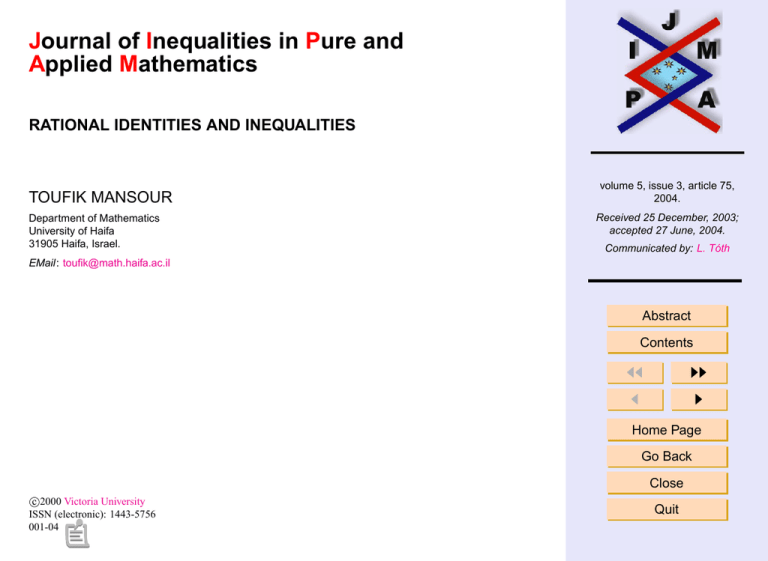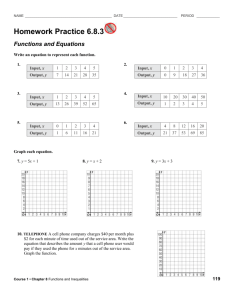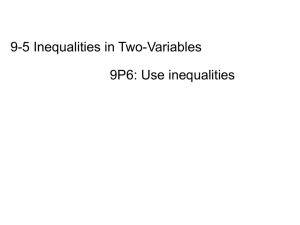Document 10706886
advertisement

Journal of Inequalities in Pure and
Applied Mathematics
RATIONAL IDENTITIES AND INEQUALITIES
TOUFIK MANSOUR
Department of Mathematics
University of Haifa
31905 Haifa, Israel.
volume 5, issue 3, article 75,
2004.
Received 25 December, 2003;
accepted 27 June, 2004.
Communicated by: L. Tóth
EMail: toufik@math.haifa.ac.il
Abstract
Contents
JJ
J
II
I
Home Page
Go Back
Close
c
2000
Victoria University
ISSN (electronic): 1443-5756
001-04
Quit
Abstract
Recently, in [4] the author studied some rational identities and inequalities involving Fibonacci and Lucas numbers. In this paper we generalize these rational identities and inequalities to involve a wide class of sequences.
2000 Mathematics Subject Classification: 05A19, 11B39.
Key words: Rational Identities and Inequalities, Fibonacci numbers, Lucas numbers,
Pell numbers.
Rational Identities and
Inequalities
The author is grateful to Díaz-Barrero for his careful reading of the manuscript.
Toufik Mansour
Contents
1
Introduction . . . . . . . . . . . . . . . . . . . . . . . . . . . . . . . . . . . . . . . . .
2
Identities . . . . . . . . . . . . . . . . . . . . . . . . . . . . . . . . . . . . . . . . . . . .
3
Inequalities . . . . . . . . . . . . . . . . . . . . . . . . . . . . . . . . . . . . . . . . . .
References
Title Page
3
4
7
Contents
JJ
J
II
I
Go Back
Close
Quit
Page 2 of 11
J. Ineq. Pure and Appl. Math. 5(3) Art. 75, 2004
http://jipam.vu.edu.au
1.
Introduction
The Fibonacci and Lucas sequences are a source of many interesting identities
and inequalities. For example, Benjamin and Quinn [1], and Vajda [5] gave
combinatorial proofs for many such identities and inequalities. Recently, DíazBarrero [4] (see also [2, 3]) introduced some rational identities and inequalities
involving Fibonacci and Lucas numbers. A sequence (an )n≥0 is said to be positive increasing if 0 < an < an+1 for all n ≥ 1, and complex increasing if
0 < |an | ≤ |an+1 | for all n ≥ 1. In this paper, we generalize the identities
and inequalities which are given in [4] to obtain several rational identities and
inequalities involving positive increasing sequences or complex sequences.
Rational Identities and
Inequalities
Toufik Mansour
Title Page
Contents
JJ
J
II
I
Go Back
Close
Quit
Page 3 of 11
J. Ineq. Pure and Appl. Math. 5(3) Art. 75, 2004
http://jipam.vu.edu.au
2.
Identities
In this section we present several rational identities and inequalities by using
results on contour integrals.
Theorem 2.1. Let (an )n≥0 be any complex increasing sequence such that ap 6=
aq for all p 6= q. For all positive integers r,
!
n
n
X
1 + a`r+k Y
(−1)n+1
−1
= Qn
(ar+k − arj )
ar+k j=1, j6=k
j=1 ar+j
k=1
holds, with 0 ≤ ` ≤ n − 1.
Rational Identities and
Inequalities
Toufik Mansour
Proof. Let us consider the integral
1 + z`
dz,
γ zAn (z)
Q
where γ = {z ∈ C : |z| < |ar+1 |} and An (z) = nj=1 (z P
− ar+j ). Evaluating
the integral I in the exterior of the γ contour, we get I1 = nk=1 Rk where
!
n
n
1 + a`r+k Y
1 + z` Y
(z − arj )−1 =
(ar+k − arj )−1 .
Rk = lim
z→ar+k
z j=1, j6=k
ar+k j=1, j6=k
1
I=
2πi
I
On the other hand, evaluating I in the interior of the γ contour, we obtain
1+z
1
(−1)n
I2 = lim
=
= Qn
.
z→0 An (z)
An (0)
j=1 ar+j
Using Cauchy’s theorem on contour integrals we get that I1 + I2 = 0, as
claimed.
Title Page
Contents
JJ
J
II
I
Go Back
Close
Quit
Page 4 of 11
J. Ineq. Pure and Appl. Math. 5(3) Art. 75, 2004
http://jipam.vu.edu.au
Theorem 2.1 for an = Fn the n Fibonacci number (F0 = 0, F1 = 1, and
Fn+2 = Fn+1 + Fn for all n ≥ 0) gives [4, Theorem 2.1], and for an = Ln the
n Lucas number (L0 = 2, L1 = 1, and Ln+2 = Ln+1 + Ln for all n ≥ 0) gives
[4, Theorem 2.2]. As another example, Theorem 2.1 for an = Pn the nth Pell
number (P0 = 0, P1 = 1, and Pn+2 = Pn+1 + Pn for all n ≥ 0) we get that
!
n
n
`
X
Y
1 + Pr+k
(−1)n+1
(Pr+k − Prj )−1 = Qn
Pr+k j=1, j6=k
j=1 Pr+j
k=1
holds, with 0 ≤ ` ≤ n − 1. In particular, we obtain
Corollary 2.2. For all n ≥ 2,
Toufik Mansour
2
Pn (Pn+1
+ 1)Pn+2
(Pn2 + 1)Pn+1 Pn+2
+
(Pn+1 − Pn )(Pn+2 − Pn ) (Pn − Pn+1 )(Pn+2 − Pn+1 )
2
Pn Pn+1 (Pn+2
+ 1)
= 1.
+
(Pn − Pn+2 )(Pn+1 − Pn+2 )
Theorem 2.3. Let (an )n≥0 be any complex increasing sequence such that ap 6=
aq for all p 6= q. For all n ≥ 2,
n
n
Y
X
1
aj
1−
= 0.
n−2
a
a
k
k
j=1, j6=k
k=1
Title Page
Contents
JJ
J
II
I
Go Back
Close
Quit
Page 5 of 11
Proof. Let us consider the integral
1
I=
2πi
Rational Identities and
Inequalities
I
γ
z
dz,
An (z)
J. Ineq. Pure and Appl. Math. 5(3) Art. 75, 2004
http://jipam.vu.edu.au
Q
where γ = {z ∈ C : |z| < |an+1 |} and An (z) = nj=1 (z − ar+j ). Evaluating
the integral I in the exterior of the γ contour, we get I1 = 0. Evaluating I in the
interior of the γ contour, we obtain
I2 =
n
X
Res(z/An (z); z = ak )
k=1
n
n
X
Y
ak
ak − aj
k=1 j=1, j6=k
n
n
X
Y
1
aj
=
1−
.
ak
an−2 j=1, j6=k
k=1 k
=
Using Cauchy’s theorem on contour integrals we get that I1 + I2 = 0, as
claimed.
For example, Theorem 2.3 for an = Ln the nth Lucas number gives [4,
Theorem 2.5]. As another example, Theorem 2.3 for an = Pn the nth Pell
number obtains, for all n ≥ 2,
n
n
Y
X
1
Pj
1−
= 0.
Pk
P n−2 j=1, j6=k
k=1 k
Rational Identities and
Inequalities
Toufik Mansour
Title Page
Contents
JJ
J
II
I
Go Back
Close
Quit
Page 6 of 11
J. Ineq. Pure and Appl. Math. 5(3) Art. 75, 2004
http://jipam.vu.edu.au
3.
Inequalities
In this section we suggest some inequalities on positive increasing sequences.
Theorem 3.1. Let (an )n≥0 be any positive increasing sequence such that a1 ≥
1. For all n ≥ 1,
(3.1)
a
n+1
n
aann+1 + aan+1
< aann + an+1
.
and
(3.2)
Rational Identities and
Inequalities
a
a
n+2
n+2
n
n
an+1
− aan+1
< an+2
− aan+2
.
Proof. To prove (3.1) we consider the integral
Z an+1
I=
(axn+1 log an+1 − axn log an )dx.
an
Since an satisfies 1 ≤ an < an+1 for all n ≥ 1, so for all x, an ≤ x ≤ an+1 we
have that
axn log an < axn+1 log an < axn+1 logan+1 ,
hence I > 0. On the other hand, evaluating the integral I directly, we get that
a
n+1
n
n
− aann+1 ) − (aan+1
− aw
I = (an+1
n ),
Toufik Mansour
Title Page
Contents
JJ
J
II
I
Go Back
Close
Quit
Page 7 of 11
hence
a
n+1
n
< aann + an+1
aann+1 + aan+1
J. Ineq. Pure and Appl. Math. 5(3) Art. 75, 2004
http://jipam.vu.edu.au
as claimed in (3.1). To prove (3.2) we consider the integral
Z an+2
J=
(axn+2 log an+2 − axn+1 log an+1 )dx.
an
Since an satisfies 1 ≤ an+1 < an+2 for all n ≥ 0, so for all x, an+1 ≤ x ≤ an+2
we have that
axn+1 log an+1 < axn+2 log an+2 ,
hence J > 0. On the other hand, evaluating the integral J directly, we get that
a
a
n+2
n+2
n
n
I = (an+2
− aan+2
) − (an+1
− aan+1
),
Rational Identities and
Inequalities
Toufik Mansour
hence
a
a
n+2
n+2
n
n
− aan+2
− aan+1
< an+2
an+1
Title Page
as claimed in (3.2).
For example, Theorem 3.1 for an = Ln the nth Lucas number gives [4,
Theorem 3.1]. As another example, Theorem 3.1 for an = Pn the nth Pell
number obtains, for all n ≥ 1,
Contents
JJ
J
II
I
P
Pn
n+1
PnPn+1 + Pn+1
< PnPn + Pn+1
,
where Pn is the nth Pell number.
Close
Theorem 3.2. Let (an )n≥0 be any positive increasing sequence such that a1 ≥
1. For all n, m ≥ 1,
n
aan+m
m−1
Y
j=0
Go Back
a
n+j+1
an+j
<
m
Y
j=0
Quit
Page 8 of 11
a
n+j
an+j
.
J. Ineq. Pure and Appl. Math. 5(3) Art. 75, 2004
http://jipam.vu.edu.au
Proof. Let us prove this theorem by induction on m. Since 1 ≤ an < an+1 for
an+1 −an
an+1
n
all n ≥ 1 then aann+1 −an < an+1
, equivalently, aann+1 aan+1
< aann an+1
, so the
theorem holds for m = 1. Now, assume for all n ≥ 1
n
aan+m−1
m−2
Y
an+j+1
an+j
<
j=0
m−1
Y
a
n+j
an+j
.
j=0
On the other hand, similarly as in the case m = 1, for all n ≥ 1,
−a
a
a
n
n+m
n+m
< an+m
an+m−1
−an
.
Rational Identities and
Inequalities
Hence,
an+m −an an
an+m−1
an+m−1
m−2
Y
an+j+1
an+j
an+m −an
an+m
<
j=0
m−1
Y
Toufik Mansour
an+j
an+j
,
j=0
Title Page
equivalently,
n
aan+m
m−1
Y
an+j+1
an+j
j=0
<
m
Y
Contents
an+j
an+j
,
JJ
J
j=0
as claimed.
II
I
Theorem 3.2 for an = Ln the nth Lucas number and m = 3 gives [4, Theorem 3.3].
Go Back
Theorem 3.3. Let (an )n≥0 and (bn )n≥0 be any two sequences such that 0 <
an < bn for all n ≥ 1. Then for all n ≥ 1,
Quit
n
X
i=1
n+1
(bj + aj ) ≥
2n
(n + 1)n
n
Y
i=1
1+1/n
bj
1+1/n
aj
−
b j − aj
.
Close
Page 9 of 11
J. Ineq. Pure and Appl. Math. 5(3) Art. 75, 2004
http://jipam.vu.edu.au
Proof. Using the AM-GM inequality, namely
n
n
Y 1/n
1X
xi ≥
xi ,
n i=1
i=1
where xi > 0 for all i = 1, 2, . . . , n, we get that
Z
a1
Z
an
···
b1
bn
n
1X
xi dx1 · · · dxn ≥
n i=1
Z
a1
Z
an
···
b1
bn
n
Y
1/n
xi dx1 · · · dxn ,
i=1
equivalently,
n
n
n Y
Y
n
1 X 2
1+1/n
1+1/n
2
(b − ai )
(bj − aj ) ≥
(bi
− ai
) ,
2n i=1 i
n
+
1
i=1
j=1, j6=i
hence, on simplifying the above inequality we get the desired result.
−1
Theorem 3.3 for an = L−1
n where Ln is the nth Lucas number and bn = Fn
where Fn is the nth Fibonacci number gives [4, Theorem 3.4].
Rational Identities and
Inequalities
Toufik Mansour
Title Page
Contents
JJ
J
II
I
Go Back
Close
Quit
Page 10 of 11
J. Ineq. Pure and Appl. Math. 5(3) Art. 75, 2004
http://jipam.vu.edu.au
References
[1] A.T. BENJAMIN AND J.J. QUINN, Recounting Fibonacci and Lucas identities, College Math. J., 30(5) (1999), 359–366.
[2] J.L. DíAZ-BARRERO, Problem B-905, The Fibonacci Quarterly, 38(4)
(2000), 373.
[3] J.L. DíAZ-BARRERO, Advanced problem H-581, The Fibonacci Quarterly, 40(1) (2002), 91.
[4] J.L. DíAZ-BARRERO, Rational identities and inequalities involving Fibonacci and Lucas numbers, J. Inequal. in Pure and Appl. Math., 4(5)
(2003), Art. 83. [ONLINE http://jipam.vu.edu.au/article.
php?sid=324]
[5] S. VAJDA, Fibonacci and Lucas numbers and the Golden Section, New
York, Wiley, 1989.
Rational Identities and
Inequalities
Toufik Mansour
Title Page
Contents
JJ
J
II
I
Go Back
Close
Quit
Page 11 of 11
J. Ineq. Pure and Appl. Math. 5(3) Art. 75, 2004
http://jipam.vu.edu.au



